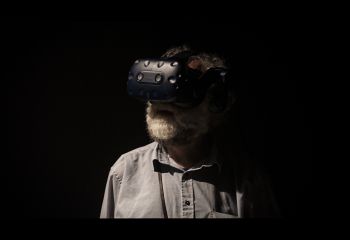

A theatrical journey through a performative multimedia installation
Duration: 1h 30'
On 25 Nov. in English.
On 26 Nov. in Hungarian.
On 27 Nov. in Romanian.
Available until: 30 Nov.
Age recommendation: 14+
Crina Andriuca
Catalina Nichitin
Lorena Copil
Raluca Marina Gheorghiu
Júlia Laczó
Eszter Román
Poem translation and voiceover in Hungarian: Eszter Tompa
Voiceover in Romanian and English: Lorena Copil
Created by CĂTĂLIN BOCÎRNEA
Set design: Florin Terec
Sound design: Men-D
Video design: Puiac Virgil
Producer: Thomas Mendel

With the support of: Madd Electronics , 4DPixel, Insomnia Cafe, Hungarian Theatre of Cluj
ESCAPIST.fbx had its unofficial opening on July 1, 2020 in Brussels, Belgium, during the Covid-19 lockdown and offered to its audience the possibility to witness and explore a new multiverse in today's Age of Participation.
The Interactive Multimedia VR Installation ESCAPIST.fbx created by Cătălin Bocîrnea, brings together xGens, Millennials, and Boomers via a spirited 3-stage Virtual-Reality journey that folds back within itself like a Shakespearean twist.
The performance spurs a roller-coaster of emotions and thoughts, turning the observer into a co-author, mixing reality with the VR that unfolds in real-time and deeply connects real persons with unforgettable 3D animated avatars.
Before stepping in, think about this: how easy is it these days for a random adult to freely hang out with a teenager that's a complete stranger, explore personal spaces together and debate freely?
When can a stranger be allowed within such a meeting, along with the post-spectatorship power to steer that young wholesome vehicle of angst and incipience? Rarely to never, since those boundaries are oozing of taboo.
But right here, yes.
ESCAPIST.fbx teleports the viewer from a Covid-ridden reality full of boundaries into a mirrored virtual geography, who then gets blitz-charmed by an avatar's authenticity to dive into a most unexpected Rabbit hole. VR re-enables the one-on-one personal connection we lack across generations; advice and personal experience shift into action, while the changeling, endearing plot is embedded into the living hypertext of today's pan-issues (anti-racism, activism, responsibility, coming-of-age, parenthood).
The performance takes a single person at a time through three multimedia installations, in three distinct spaces gradually dialed up in intimacy; it starts from a contemplative position of a witness, graduates into a participatory VR adventure and ends in mind blowing introspection and meta-spectatorship. The questions it raises are tactical, but also existential: how far can direct influence, ethics, closeness, innocence, and sharp consequence go?
The Journey is lite, hypnotic, beguiling, but it becomes morally complex and potentially deadly with its coup at the end and plays out on multiple emotional and cognitive levels.